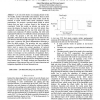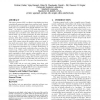92 search results - page 16 / 19 » Detecting Unknown Worms Using Randomness Check |
ALMOB
2006
13 years 7 months ago
2006
The main goal of the motif finding problem is to detect novel, over-represented unknown signals in a set of sequences (e.g. transcription factor binding sites in a genome). The mo...
INFOCOM
2009
IEEE
14 years 2 months ago
2009
IEEE
—The performance of randomized network coding can suffer significantly when malicious nodes corrupt the content of the exchanged blocks. Previous work have introduced error corr...
ICCCN
2007
IEEE
14 years 1 months ago
2007
IEEE
— Low rate DoS attacks are emerging threats to the TCP traffic, and the VoIP traffic in the Internet. They are hard to detect as they intelligently send attack traffic inside the...
ACMSE
2006
ACM
14 years 1 months ago
2006
ACM
Software researchers have already developed static code security checkers to parse through and scan source code files, looking for security vulnerabilities [8, 9]. What about exec...
CCS
2006
ACM
13 years 11 months ago
2006
ACM
This paper presents EXE, an effective bug-finding tool that automatically generates inputs that crash real code. Instead of running code on manually or randomly constructed input,...


